Vehicle Barriers
Full containment and control of vehicles are required at all ECFs. To contain a threat vehicle, an ECF utilizes passive and active vehicle barriers. Passive barriers direct and channelize traffic while active barriers are used only upon activation by personnel, equipment, or both. Passive and active barriers are designed based on their ability to stop threat vehicles.
Passive Barriers
Passive barriers are generally parallel to the direction of travel. They should be arranged to prevent a vehicle from circumventing the ECF.
Ideally, crashworthy barriers such as guardrails, earthen berms, or high sloped face curbing should be used.
Non-crashworthy barriers like reinforced walls, reinforced fences, trees, or bollards should be located outside of the clear zone.
It is important to note that only passive barrier devices found in the most recent publication of the DOD Anti-Ram Vehicle Barrier List are considered compliant forms of passive barrier.
Refer to the Army Corps of Engineers Digital Library here: DOD Anti-Ram Vehicle Barrier List
| Passive Barrier |
Requirements |
| Cables |
Horizontal deflection may be high.
May not immobilize larger vehicles.
Damage at any point in the system may require repairs to large sections of the system.
|
| Portable |
Useful for establishing a controlled perimeter under temporary conditions.
|
| Inertial |
Careful design is required to contain threat vehicle and to limit ramping.
May help control ECF and limit view of ECF and installation from exterior areas.
|
| Post and Beam |
Can be located in clear zone if crashworthy but should be located outside clear zone, if possible.
May not prevent head-on penetration.
May not immobilize larger vehicles.
|
| Reinforced Fencing |
Must be reinforced to stop threat vehicle.
Can be aesthetically pleasing
|
| Bollard |
Must be large enough and spaced frequently enough to stop threat vehicle.
Can be aesthetically pleasing.
|
Active Barriers
Many installations use active barriers as arresting devices to stop unauthorized vehicles. Some drivers who attempt to enter the installation without authorization are lost, confused, or inattentive, but there are also those with hostile intentions. A properly designed barrier minimizes the risk to those making an honest mistake and stops those with hostile intentions. There are several different types of barriers available, some of which are better suited to different applications.
The placement of a barrier must allow for sufficient response time after the ID checkpoint area between the time that the threat vehicle is detected, the guard reacts to the threat, a signal in front of the barrier properly sequences, and the barrier activates. TEA has developed multiple barrier safety schemes, one of which must be used with any active barrier installation. The barrier safety scheme can vary depending on space available, and roadway geometry.
| Type |
Pros |
Cons |
Nets
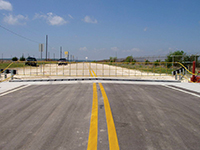 |
Less likely to be lethal
Can deploy in less than 2 seconds
Limited hydraulics below grade
Spans multiple lanes (reduce costs)
Reusable after impact
More than one manufacturer
|
Limited surface area for delineation
Concerns over motorcycles when traversing in down position
Need to channel pedestrians away from roadside AVB area |
Wedges
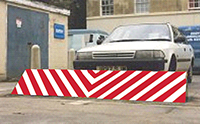
|
Can deploy in less than 2 seconds
Significant surface for delineation
|
Fixed object
In-ground hydraulics
May require replacement if struck |
Bollards
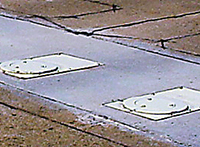 |
Can deploy in less than 2 seconds
Can be used for partial closures
|
Vehicle intrusion on impact
Gaps greater than 3 feet are a potential vulnerability
Limited surface area for delineation
In-ground hydraulics
May require replacement if struck |
Crash Beams
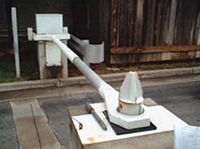
|
Most suited to barrier normally closed use in low volume conditions
Better suited for cold weather locations
|
Vehicle intrusion on impact
Limited surface area for delineation
In-ground hydraulics
Deployment times may exceed 2 seconds
May require replacement if struck |
Portable Barriers
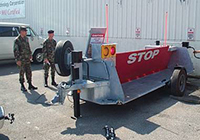
|
Most suited to barrier normally closed use in low volume conditions
|
May damage undercarriage of vehicles through normal use
May require replacement if struck |
The placement of a barrier must allow for sufficient response time after the ID checkpoint area between the time that the threat vehicle is detected, the guard reacts to the threat, a signal in front of the barrier properly sequences, and the barrier activates. TEA has developed multiple barrier safety schemes, one of which must be used with any active barrier installation. The barrier safety scheme can vary depending on space available, and roadway geometry.
0-Second Full Containment Scheme: These barriers are always closed and opened for authorized vehicles. Traffic flow is considerably slower, but this safety system can be acceptable in low volume applications. No time is needed for these systems since the barriers are up.
5-Second Stop Control Safety System: This system was initiated by the need to retrofit AVB safety at constrained locations with relatively low traffic volume; less than 800 vehicles per hour per lane. This system requires all vehicles inbound and outbound to stop at the AVB. This requirement effectively eliminates the need to transition from a green signal to a red.
7-Second Hybrid Beacon Safety Scheme: The Hybrid Beacon Safety Scheme uses hybrid beacons for traffic control and extended vehicle detection loops to detect the presence of vehicles approaching the AVB. The safety scheme’s design provides adequate stopping sight distance for an innocent driver to stop prior to, or to clear, the AVB.
9-Second Hybrid Beacon Safety Scheme: The 9-second Hybrid Beacon Safety Scheme uses signals located with sufficient distance to provide adequate warning to drivers to stop in advance of the barriers. This system allows the free flow of vehicles, through the AVB, allowing high traffic volume requirements to be met.
There are also applications for combining these schemes, where one scheme would be used inbound and another outbound. If the barriers are located at an intersection, special considerations are required. Either relocate the barriers for the outbound direction between the ID check and the intersection, or if the outbound barriers must be located at the intersection, a longer response time (12 seconds) must be used.


